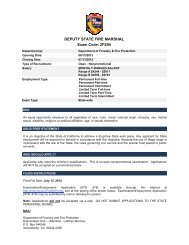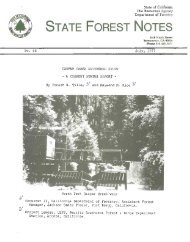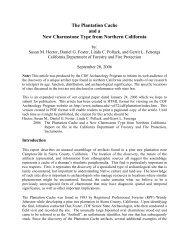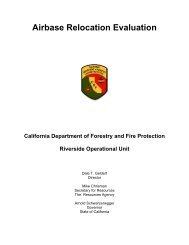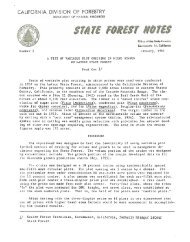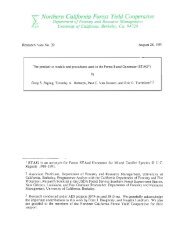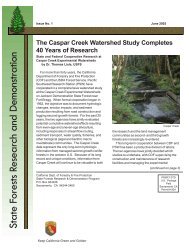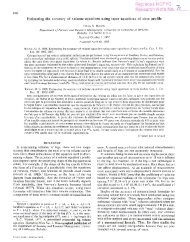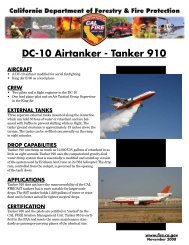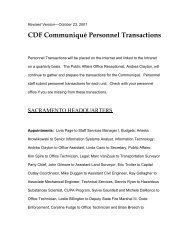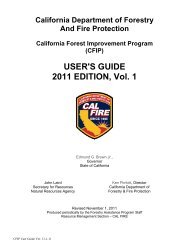CALIFORNIA FORESTRY NOTE - Demoforests.net
CALIFORNIA FORESTRY NOTE - Demoforests.net
CALIFORNIA FORESTRY NOTE - Demoforests.net
Create successful ePaper yourself
Turn your PDF publications into a flip-book with our unique Google optimized e-Paper software.
- -<br />
r--- .... ..<br />
No. 117<br />
<strong>CALIFORNIA</strong> <strong>FORESTRY</strong> <strong>NOTE</strong><br />
State of California<br />
The Resources Agency<br />
California Departmentof Forestry & Fire Protection<br />
CONVERTING SAL VAGE TIMBER TO<br />
LUMBER ON SENSITIVE SITES USING<br />
THE CHICO MOSS<br />
ON LATOUR DEMONSTRATION STATE<br />
FOREST<br />
Ronald W. Hodgson, Ph.D., Michael Jones,<br />
Scott R. McDonald, Dan Walters 1<br />
ABSTRACT<br />
po. Box 944246<br />
Sacramento, CA 94244-2460<br />
Phone 916-653-7209<br />
Web: www.fire.ca.gov<br />
November 2004<br />
The Chico Milled-an-Site System (Chico<br />
MOSS) is a combination of a highly portable<br />
sawmill and "Zig Zag" yarder. Using the Chico<br />
MOSS, logs can be milled into lumber at the<br />
location where the tree is felled, without<br />
having to skid the logs or move in heavy<br />
equipment. The milled lumber, which can be<br />
fully suspended, is yarded to a landing 1000<br />
feet or more from the felled tree. With the<br />
Chico MOSS no new roads or skid trails need Using the portable mill to saw cants from logs at the stump.<br />
to be constructed to access felled timber.<br />
neighborhoods where fire hazard reduction,<br />
Minimal soil disturbance or damage to the hazard tree removal, or insect infestation<br />
residual stand is created, making the Chico control is vital for community safety.<br />
MOSS an option for highly selective<br />
commercial thinning and harvesting of stands The Chico MOSS is an alternative that should<br />
on sensitive sites. The Chico MOSS may be<br />
also be considered on less sensitive sites,<br />
used in riparian areas, on archaeological such as when seasonally saturated soils<br />
sites, steep slopes, erodible soils, and in deny access to heavy equipment or in stands<br />
densely populated wildland-urban intermix of insect damaged trees where total available<br />
1 Respectively, Professor of Parks and Natural Resources Management; California State University, Chico (retired);<br />
OperationsChief, Fire and Ecosystem Management Project, California State University, Chico Research Foundation;<br />
Forest Manager and Assistant Forest Manager (retired), La Tour Demonstration State Forest, California Department<br />
of Forestry and Fire Protection.
~<br />
. . -<br />
..<br />
i<br />
\ ~A ~> ,..4'<br />
\.' ;. .~><br />
f' ..'. ", ;1'. " ~~.. 'il<br />
J - l~-'(-:<br />
Cants ready to yard using the Zig Zag yarder. Note<br />
cable above cants.<br />
volume is insufficient to justify conventional<br />
harvesting. The Chico MOSS is available for<br />
use in conjunction with traditional harvesting<br />
operations to access islands of timber that<br />
may be unavailable to other harvesting<br />
equipment due to unfavorable topography, or<br />
other obstructions.<br />
. This study demonstrated that it is technically<br />
feasible for the Chico MOSS to mill and yard<br />
lumber on site. The authors identified several<br />
potential modifications to the equipment that<br />
would make it more efficient and easier to<br />
use. Additional studies of the Chico MOSS<br />
will be needed to determine its economic<br />
feasibility.<br />
INTRODUCTION<br />
California has many wildland-urban intermix<br />
(I-Zone) communities located in timber stands<br />
characterized by closed canopy, dense highly<br />
2<br />
flammable suppressed understory,<br />
accumulations of dead woody material, and/<br />
or a species mix atypical of the native forest.<br />
Current conditions make these stands highly<br />
susceptible to insect attack, disease, drought,<br />
and wildfire. These threats may be mitigated<br />
through vegetation management practices<br />
designed to restore stands to a sustainable<br />
and non-catastrophic fire composition and<br />
structure. Perceived costs may deter many 1-<br />
Zone property owners from implementing<br />
effective fire hazard mitigation on their lands<br />
or on the common lands within subdivisions.<br />
One of the methods to reduce the cost of fire<br />
hazard mitigation is the salvage of valuable<br />
commercial wood products.<br />
In many areas of the wildland-urban intermix,<br />
the current available commercial approaches<br />
to fire hazard reduction are unacceptable to<br />
the public because of aesthetics, noise,<br />
traffic, environmental, and safety concerns.<br />
Lumber produced by the Chico MOSS from<br />
salvaged trees, when sold to a sawmill or<br />
manufacturer, can provide income that will<br />
defray the cost of fire hazard reduction<br />
practices to I-Zone property owners. Salvage<br />
projects may not pay the full cost of fire<br />
hazard reduction, but they may reduce the<br />
out-of-pocket costs to the landowner.<br />
OBJECTIVES<br />
In this study the Fire and Ecosystem<br />
Management project of the California State<br />
University, Chico Research Foundation was<br />
seeking to find and test methods that will<br />
increase the cost-effectiveness of fire and<br />
forest health hazard mitigation in the I-Zone.<br />
One of these methods, the Chico MOSS, was<br />
tested on the California Department of<br />
Forestry and Fire Protection's LaTour<br />
Demonstration State Forest.
- . -- -<br />
-.<br />
FOREST DESCRIPTION<br />
LaTour Demonstration State Forest is a 9,033<br />
acre mixed conifer and true firtimber type<br />
property located at the southern end of the<br />
Cascade Range, approximately 50 miles<br />
northeast of Redding, California. Elevation<br />
ranges from 3,800 feet to 6,740 feet.<br />
MATERIAL AND METHODS<br />
THE CHICO MOSS<br />
The Chico MOSS combines two successful<br />
technologies that have been adapted to<br />
operate effectively in the wildland-urban<br />
intermix. The first is a portable saw mill<br />
designed to be disassembled for easy transportation<br />
to remote locations that are inaccessible<br />
to most other mills. The second is a<br />
continuous-loop monocable yarder, also<br />
referred to as a "Zig Zag" yarder. When used<br />
together, it is possible to fall one or more<br />
trees, move the mill using the "Zig Zag"<br />
yarder to the felled trees, mill them into<br />
lumber, and then yard the lumber to a landing<br />
where it is loaded directly onto trailers. Slash<br />
and mill waste may also be yarded to the<br />
landing where it can be chipped or used for<br />
firewood. The processing of slash and mill<br />
3<br />
waste will reduce <strong>net</strong> revenues unless these<br />
products can be sold.<br />
After a log is milled into lumber, the portable<br />
mill can then be easily moved to the next log<br />
or tree. Once milling is completed at a particular<br />
site, the mill is yarded back to the<br />
landing, loaded into a pick-up truck, and<br />
hauled to the next site. This harvesting/<br />
milling method is extremely light on the land.<br />
In the entire process, it is unnecessary to<br />
skid logs or to build new haul or tractor<br />
roads. Soil disturbance is almost nonexistent.<br />
Milled boards can be fully suspended<br />
above the ground by the "Zig Zag" yarder to<br />
protect both the wood and the site.<br />
After a log is milled into lumber, the portable<br />
mill can then be easily moved to the next log<br />
or tree.<br />
THE SAW MILL<br />
The portable sawmill is composed of a frame<br />
that is set up either directly over a log, or a log<br />
can be rolled into place for milling. A gasoline<br />
fueled powerhead rides on two rails that are<br />
adjusted up or down to precisely determine<br />
one of the two dimensions of the lumber being<br />
produced. The second dimension is<br />
determined by settings on the powerhead that<br />
determine the precise horizontal location of the<br />
blade.<br />
Loading cants on to a<br />
trailer at the landing. The<br />
yarder is mounted on the<br />
pickup in the background.
,.---<br />
- - .. -.<br />
The power head contains a circular blade<br />
that has five carbide cutters. The kerf is 3/16<br />
inches. The blade can be sharpened in five<br />
minutes using a sharpener that comes with<br />
the purchase of the mill. The blade does not<br />
need to be removed from the powerhead to<br />
be sharpened, and because the new models<br />
are "electric start", the 12-volt battery can<br />
power the sharpener. A wheel attaches to<br />
the powerhead allowing it to be pushed to<br />
most sites. If this is not feasible, the various<br />
components can be arranged to enable<br />
processing flexability. For example, ropes<br />
can be attached to the powerhead frame,<br />
which is then attached to the "Zig Zag"<br />
yarder cable, and transported to the log. The<br />
saw mill frame and rails were attached to the<br />
cable with twine chokers. The "Zig Zag"<br />
yarder transported the mill to the site of the<br />
felled tree. Once the saw mill pieces<br />
reached the site they were cut from the cable<br />
and then the mill was assembled over the log<br />
to be cut.<br />
To mill lumber the saw mill operator engages<br />
the powerhead which rides on tracks that are<br />
set up around the log being milled, making<br />
either a vertical or horizontal cut. When the<br />
powerhead reaches the end of the log being<br />
milled the blade is shifted and the second cut<br />
is completed as the powerhead is pulled<br />
back to the opposite end of the log. The<br />
operator, or a second worker, pulls the board<br />
that has just been milled and stacks it. The<br />
mill is then reset for the next cut and the<br />
process is repeated.<br />
The saw mill tested can manufacture cants<br />
up to 6.25 inches by 12.5 inches, and other<br />
models are capable of manufacturing cants<br />
up to 8.5 inches by 17 inches. Slabbing bars<br />
can be purchased which allow the mill to<br />
manufacture slabs up to 6.25 inches by 50<br />
inches from the Model 6 and 8.5 inches by<br />
60 inches with the Model 8. These mills can<br />
manufacture lumber of any size that is less<br />
than the stated maximums. The standard<br />
4<br />
mills are able to cut logs that are 48 inches in<br />
diameter and 20 feet in length without moving<br />
the end frames. Much larger logs may be cut<br />
by the mill. Diameters of 8' or larger can be<br />
manufatured by resawing cants to smaller<br />
sizes. For logs longer than 20 feet contact<br />
the manufacturer to get instructions on<br />
methodology. Two or three small diameter<br />
logs can be placed under the frame and<br />
milled in a single setup. Extensions are<br />
available which permit longer logs to be<br />
milled.<br />
THE "ZIG ZAG" YARDER<br />
The "Zig Zag" is a continuous monocable<br />
yarding system, consisting of a series of<br />
blocks that are hung from trees or spars in a<br />
"Zig Zag" pattern. In the blocks are pulleys<br />
that have a toothed flange on the bottom.<br />
The blocks are hung from trees with straps,<br />
and cable tension and friction hold the blocks<br />
in place. The blocks do not cause damage to<br />
the trees.<br />
The "Zig Zag" yarder was mounted in the<br />
back of a four- wheel drive, % ton pickup<br />
truck that makes it easy to move. The power<br />
source for the yarding system is a 12<br />
horsepower gasoline fueled engine that<br />
turns a drum around which the cable is<br />
wound. The cable is a continuous loop that<br />
is set at a constant speed. The speed of the<br />
cable is adjustable and direction can be<br />
reversed.<br />
Lumber, brush, firewood, or other material is<br />
hung from the cable by a bailing-twine choker<br />
that is looped around the material and tied to<br />
the cable with a clove hitch. Experienced<br />
workers quickly tie the clove hitch with one<br />
hand. The twine passes through the blocks<br />
and when the material being yarded reaches<br />
the landing the twine is cut. When necessary<br />
to fully suspend the material being yarded,<br />
both ends of the items are tied to the cable<br />
with the twine. The weight the "Zig Zag" can
-<br />
L- D u_- - n.. ~<br />
carry is effectively limited by what the workers<br />
can lift, not by the capacity of the machine.<br />
Distances of up to 1,000 feet were reached,<br />
but greater distances are feasible. The "Zig<br />
Zag" yarder can be set up to operate on very<br />
steep ground, over wet areas, and uneven<br />
terrain. The yarder is quick to assemble and<br />
disassemble. One thousand (1,000) foot<br />
layouts can be rigged in two hours,<br />
depending on the terrain and density of the<br />
vegetation.<br />
RESULTS<br />
The portable mill was easy to move with the<br />
"Zig Zag" yarder. Milling of logs on relatively<br />
flat, even ground proceeded without difficulty.<br />
Where logs were located on side-hills it was<br />
necessary to support the lower legs of the<br />
frame. Providing additional support to the<br />
lower legs was time consuming, resulting in<br />
decreased productivity. The frame is<br />
designed for level ground. Logs were milled<br />
into lumber on slopes ranging from 0 to 10<br />
percent.<br />
Load of lumber milled<br />
with the MOSS system<br />
leaving the La Tour<br />
Demonstration State<br />
Forest.<br />
'" <br />
5<br />
A professional faller is essential for<br />
productivity. Felling of trees to achieve the<br />
most favorable lie reduced time spent in<br />
preparing the log and setting up the mill.<br />
Production was most efficient when the<br />
lumber was cut, stacked, and then yarded.<br />
The yarding of lumber as it was milled<br />
required an additional employee at the<br />
landing, resulting in increased costs.<br />
The "Zig Zag" yarder was capable of<br />
transporting over 250 pieces of lumber an<br />
hour. The highest production obtained during<br />
an eight hour shift by a crew of 3 was 2,000<br />
board feet (2 MBF) of 4.75 inches by 5.25<br />
inch cants. Production is defined as milling,<br />
yarding, loading on to a trailer, hauling to a<br />
staging area, and then re-stacking with<br />
stickers.<br />
The largest log milled was a 42 inch diameter<br />
sugar pine, and the smallest was<br />
approximately 10 inches in diameter.<br />
Two ways to improve productivity were<br />
identified. The first was to improve the saw<br />
mill frame to reduce the time required to level
- . - -<br />
it on steep slopes. The second would be to<br />
purchase a second frame and have it<br />
assembled by one crew person over the next<br />
log to be milled, reducing down time for set<br />
up~<br />
LUMBER SALE<br />
The lumber milled was sold to a commercial<br />
saw mill in Redding, California. 11.2 MBF of<br />
cants were sold for re-sawing and<br />
processing. The Reddimg sawmill produced<br />
a total of 9.5 MBF of lumber, and $1,581 in<br />
revenue. Further studies are needed to<br />
determine the economic viability of the<br />
MOSS.<br />
COSTS<br />
The basic sawmill used in this study, the<br />
Lucas sawmill, comes with an 18 H.P. engine<br />
and it costs about $6,695. The larger model<br />
has a 25 H.P. engine and it sells for about<br />
$9,495. Both of these models have electric<br />
starts. The cost of a "Zig Zag" yarding<br />
system is approximately $20,000, without the<br />
pickup to transport it. A single "Zig Zag"<br />
system could yard for several mills, in close<br />
proximity.<br />
RECOMMENDED IMPROVEMENTS<br />
During this study several ways to improve<br />
the efficiency of the operation were<br />
identified:<br />
1) Use more than one saw mill to reduce<br />
down time.<br />
2) Develop an efficient sorting, grading, and<br />
binding method for use at the staging<br />
area.<br />
3) Develop a marketing plan for the<br />
product. Lumber milled will typically be<br />
mixed species and dimensions, in small<br />
volumes. A forest products cooperative<br />
serving a number of independent owner/<br />
operators may be the most appropriate<br />
marketingarrangement.<br />
6<br />
SUMMARY AND CONCLUSIONS<br />
The sawmill and yarder combination used in<br />
this study, called the Chico Milled On Site<br />
System (Chico MOSS), was able to mill<br />
lumber at the stump and yard it to a landing<br />
1,000 feet away without impacting the soil or<br />
the residual stand. It is technically feasible<br />
for the Chico MOSS to recover lumber from<br />
trees within the wildland-urban intermix, on<br />
residential properties and other sensitive<br />
sites. Further testing is needed to determine<br />
the financial feasibility for various settings.<br />
The term "Chico MOSS" was developed by<br />
Professor Ron Hodson of Chico State<br />
University and does not refer to any particular<br />
brand of sawmill or yarder, but to a<br />
combination of the two types of equipment.<br />
While CDF chose to use the Lucas sawmill<br />
provided by Bailey's for this study there are<br />
several other companies that produce a<br />
similar product capable of the same work.<br />
Mighty Might Industries, Inc., Portland<br />
Oregon and Mobile Manufacturing Company,<br />
Troutdale, Oregon are two examples.<br />
Support for this project came from the Califomia<br />
Department of Forestry and Fire Protection;<br />
California State University, Chico Research<br />
Foundation; and Bailey's, www.baileysonline.com,<br />
who provided the equipment for<br />
the experiment. This cooperation does not<br />
constitute an endorsement of the product by<br />
the State of California.
~<br />
- - - -<br />
Arnold Schwarzenegger<br />
Governor<br />
State of California<br />
Michael Chrisman<br />
Secretary for Resources<br />
The Resources Agency<br />
Dale 1. Geldert<br />
Director<br />
California Department of Forestry and Fire Protection
,....--<br />
. .<br />
California Dept. of Forestry & Fire Protection<br />
P.O. Box 944246<br />
Sacramento, CA 94244-2460<br />
- --




